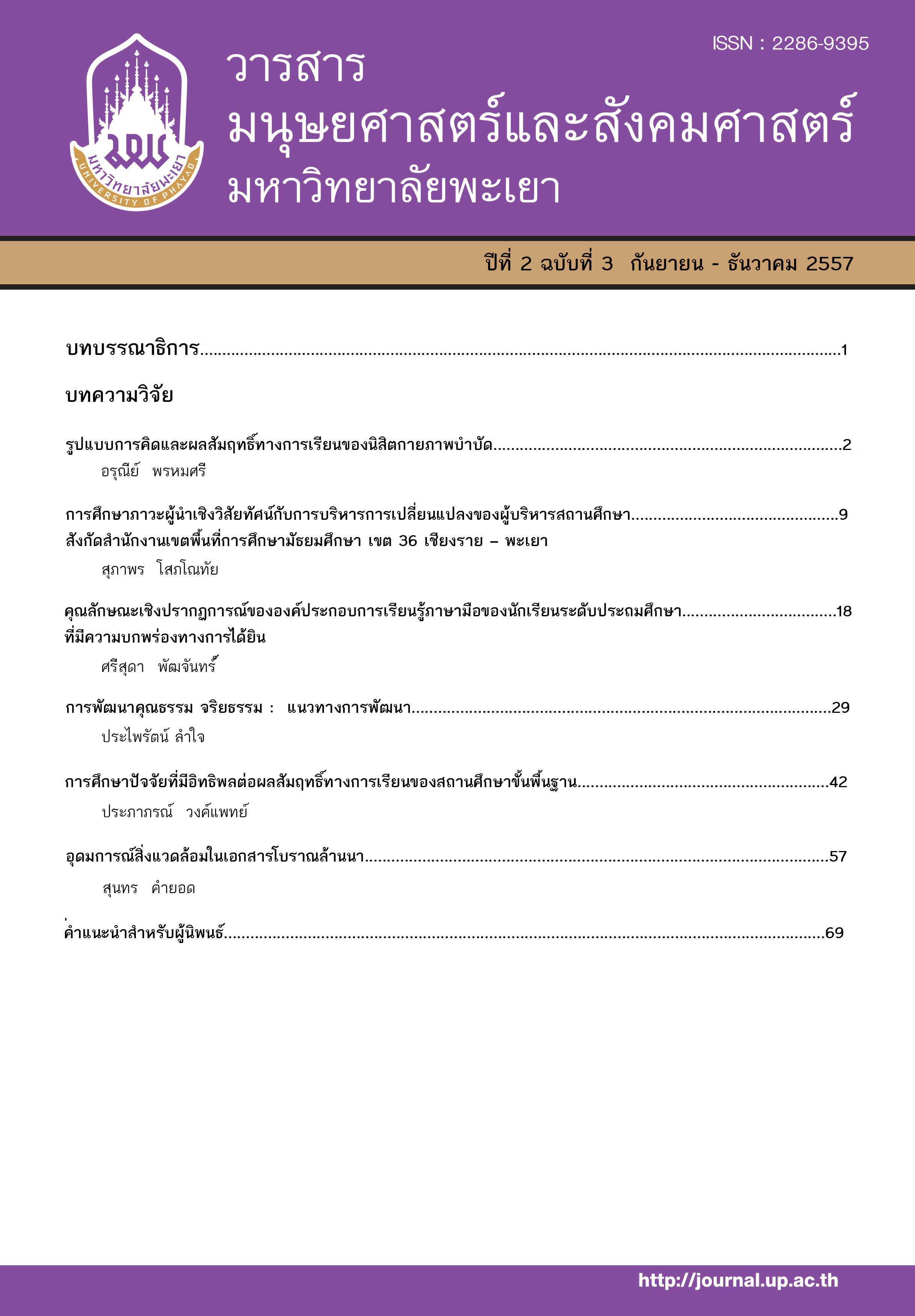Moral and Ethical Development : Development approach
Keywords:
Moral and Ethical, Moral and Ethical DevelopmentAbstract
Moral and ethical are social acceptable goodness. They are caused by communal and education by training, practice, and the action are good trait beneficial to themselves and the others. The theory and principles are article addresses six approaches to ethical development, namely: intellectual development theory, affective domain group theory, behaviorism, psycho-behavioral science, sociology and religious instruction. Furthermore, ethical development methods which rely on a basic concept in a given theory are also considered. Intellectual development theory is defined as ones’ moral development proceeds in step with and depends on one’s cognitive progress. Affective domain group theory explains individual moral development as related to the level of mental learning quality. Behaviorism focuses on giving reinforces and therefore utilizes reinforcement in order to modify a person’s ethics. Psycho-behaviorism emphasizes one’s moral development by relating it to data obtained from diverse researches, that the process and techniques of improving citizens’ ethics are very important. Sociology focuses the on the socialization process, which includes the method of bringing up and educating youth through copious agents such as parents, teachers, friends, monks and media. For religious instructors they aim to intensify individual ethics in accordance with Dharma principle, claiming this can help people to live happily in society. Although, each model contains different basic beliefs of development, there is a coincidence of modeling of the ethical development process. (The guidelines develop for moral and ethical. In children and adolescents based on the knowledge, awareness, moral consciousness of the value of philosophy.) Reconciliation nonviolent way of democratic development of the moral basis of the learning process that links your cooperation. Institutions, religious institutions, families, communities and institutions to develop youth to be good. Knowledgeable and well-being by virtues. The studied forms for moral and ethical are divided into four types: 1) model for moral and ethical by family, 2) model for moral and ethical by religious institutions, 3) model for moral and ethical by schools and 4) model for moral and ethical by community.
References
พระราชบัญญัติการศึกษาแห่งชาติ พ.ศ. 2542 และที่แก้ไขเพิ่มเติม (ฉบับที่ 2) พ.ศ.2545.19 ธันวาคม 2545. ราชกิจจานุเบกษา. เล่ม 119 ตอนที่ 99 ก..
แผนการศึกษาแห่งชาติ (พ.ศ. 2545-2559). (2545). สำนักงานคณะกรรมการการศึกษาแห่งชาติ สำนักนายกรัฐมนตรี (พิมพ์ครั้งที่ 2). กรุงเทพฯ; พริกหวานกราฟฟิค จำกัด.
สำนักงานคณะกรรมการการศึกษาแห่งชาติ. (2545). แนวทางการวัดผลประเมินผลในชั้นเรียนกลุ่มสาระวิทยาศาสตร์ หลักสูตรการศึกษาขั้นพื้นฐาน พุทธศักราช 2544. กรุงเทพมหานคร; โรงพิมพ์องค์การรับส่งสินค้าและพัสดุภัณฑ์ (ร.ส.พ.): หน้า 30.
กระทรวงวัฒนธรรม. (2550). โครงการยกย่องชูเกียรติบุคคลและสถาบันดีเด่นทางวัฒนธรรมของสำนักงานคณะกรรมการวัฒนธรรมแห่งชาติ. เข้าถึงได้จาก http//www.m-culture.go.th: หน้า 10.
กระทรวงศึกษาธิการ. (2550). การจัดการเรียนรูปแบบกระบวนการแก้ปัญหา. กรุงเทพฯ; ชุมนุมสหกรณ์การเกษตรแห่งประเทศไทย.
กรมการศาสนา. (2551). กรมการศาสนา. กรุงเทพฯ; โรงพิมพ์ชุมชนสหกรณ์การเกษตรแห่งประเทศไทย.
กีรติ บุญเจือ. (2542). จริยศาสตร์สำหรับผู้เริ่มเรียน. กรุงเทพฯ; สำนักพิมพ์ไทยวัฒนาพานิช: หน้า 3-4.
ดวงเดือน พันธุมนาวิน. (2522). การพัฒนาจริยธรรมของเยาวชนไทย. กรุงเทพฯ: มหาวิทยาลัยศรีนครินทร- วิโรฒ ประสานมิตร: หน้า 3.
พระราชวรมุนี (ประยุทธ์ ปยุตโต). (2530). ทางสายกลางของการศึกษาไทย. กรุงเทพฯ; สำนักพิมพ์อัมรินทร์: หน้า 10.
บุญมี แท่นแก้ว. (2538). จริยศาสตร์. พิมพ์ครั้งที่ 3. กรุงเทพฯ; สำนักพิมพ์ไทยวัฒนาพานิช. หน้า 167.
สุชาติ ประสิทธิ์รัฐสินธุ์. (2542). จริยธรรมทางวิชาการ (พิมพ์ครั้งที่ 2). กรุงเทพฯ; สำนักพิมพ์สถาบันบัณฑิตพัฒนบริหารศาสตร์: หน้า 3.
ประภาศรี สีหอำไพ. (2538). พื้นฐานการศึกษาทางศาสนาและจริยธรรม. กรุงเทพฯ; โรงพิมพ์แห่งจุฬาลงกรณ์มหาวิทยาลัย: หน้า 3.
Rest, J. (1969). Level of moral development as the determinant of preference and comprehension of moral judgments made by others. Journal of Personality, 37. p.6.
Brown, R. (1968). Social Psychology. New York: The Free Press. p.411-414.
พระธรรมปิฎก (ป.อ.ปยุตโต). (2543). พุทธวิธีแก้ปัญหาเพื่อศตวรรษที่ 21. กรุงเทพฯ; มูลนิธิพุทธธรรม: หน้า 9.
สมบูรณ์ ชิตพงศ์. (2544). เอกสารการสอนชุดวิชาสถิติ และการประเมินผลทางการศึกษา. กรุงเทพฯ; ห้างหุ้นส่วนจำกัด อรุณการพิมพ์: หน้า 6-7.
วิลาสลักษณ์ ชัววัลลี. (2552). จริยธรรมในเด็กและเยาวชน. วารสารพฤตกรรมศาสตร์, 15(1), หน้า 16-27.
Kohlberg, L. (1976). Moral Stage and Moralization: The Cognitive Development Approach. Moral Development and Behavior. Ed. by Thomas Lickona, New York : Holt Rinehart and Winston.
อ้อมเดือน สดมณี. (2557). การพัฒนาคุณธรรม จริยธรรม : จากแนวคิดสู่การปฏิบัติ. วารสารพฤติกรรมศาสตร์ ปีที่ 17 ฉบับที่ 1 มกราคม 2557. หน้า 22.
Piaget, J. (1971). The Theory of Stages in Cognitive Development. In D.R. Green (Ed.), Measurement and Piaget. New York: McGraw-Hill.
ดวงเดือน พันธุมนาวิน. (2524). พฤติกรรมศาสตร์ เล่ม 2 : จิตวิทยาจริยธรรมและจิตวิทยาภาษา. กรงเทพฯ; ไทยวัฒนาพาณิช: หน้า 29-30.
ดวงเดือน พันธุมนาวิน. (2541). รูปแบบปฎิสัมพันธ์นิยม (Interactionism Model) เพื่อการวิจัยสาเหตุของพฤติกรรมและพัฒนาพฤติกรรมมนุษย์. วารสาร ทันตาภิบาล, 10(2), หน้า 105-108.
Munn, N. L., Fernald, L. D., & Fernald, P.S. (1969). Introduction to psychology. (2nd ed.). Boston: Houghton Mifflin.
Bloom, L., & Selznick, P. (1968). Sociology. New York : Harper & Row.
งามตา วนินทานนท์. (2553). ชุดงานวิจัยเพื่อสร้างดัชนีคุณภาพชีวิตครอบครัวไทยและประยุกต์ใช้ผลวิจัย.วารสารพฤติกรรมศาสตร์, 16(1). หน้า 17-40.
ภัทรพร ศิริกาญจน. (2536). ความรู้พื้นฐานทางศาสนา. กรุงเทพฯ; มหาวิทยาลัยธรรมศาสตร์.
Downloads
Published
How to Cite
Issue
Section
License
ผู้นิพนธ์ต้องรับผิดชอบข้อความในบทนิพนธ์ของตน มหาวิทยาลัยพะเยาไม่จำเป็นต้องเห็นด้วยกับบทความที่ตีพิมพ์เสมอไป ผู้สนใจสามารถคัดลอก และนำไปใช้ได้ แต่จะต้องขออนุมัติเจ้าของ และได้รับการอนุมัติเป็นลายลักษณ์อักษรก่อน พร้อมกับมีการอ้างอิงและกล่าวคำขอบคุณให้ถูกต้องด้วย
The authors are themselves responsible for their contents. Signed articles may not always reflect the opinion of University of Phayao. The articles can be reproduced and reprinted, provided that permission is given by the authors and acknowledgement must be given.








